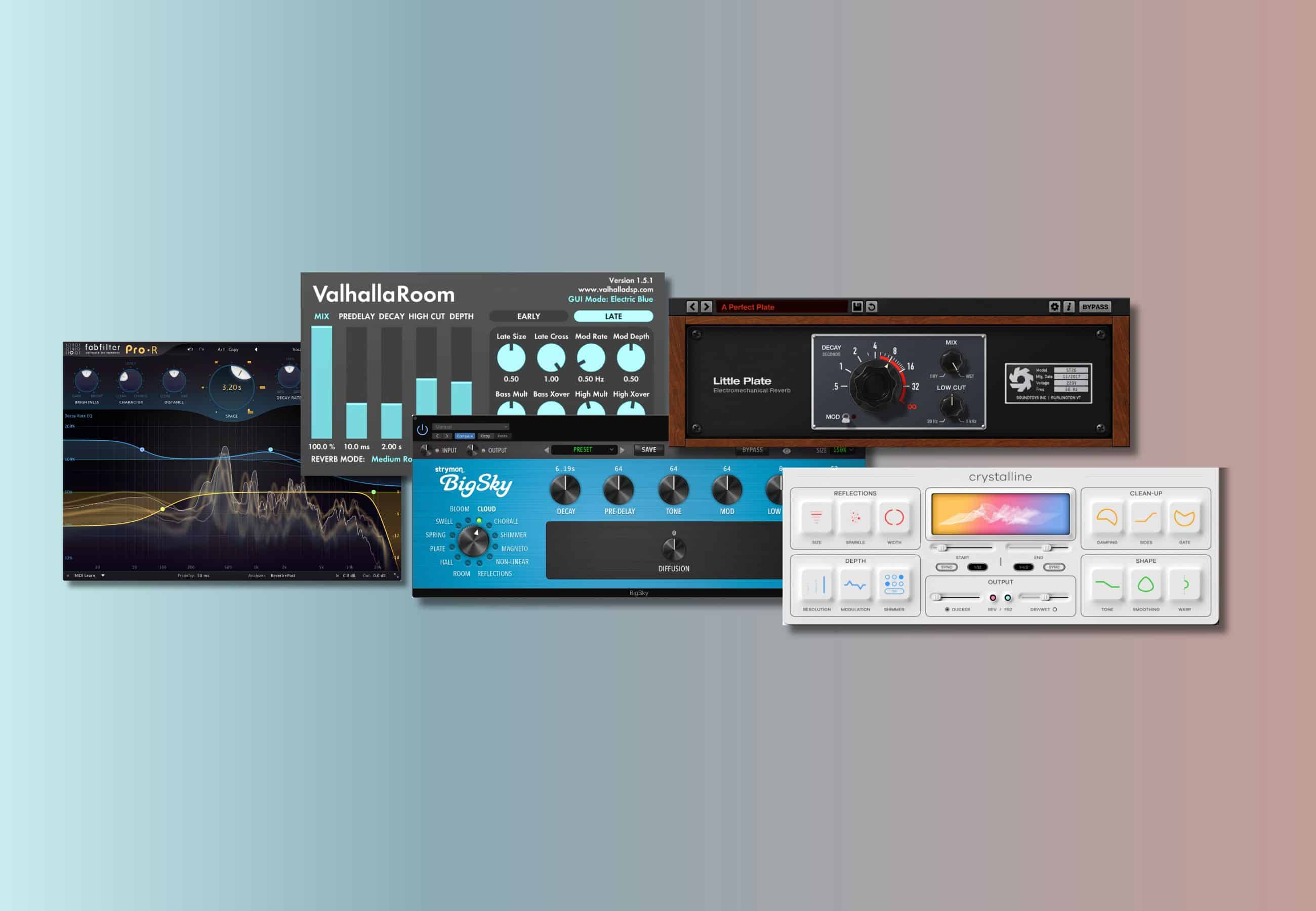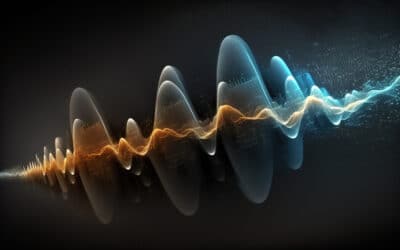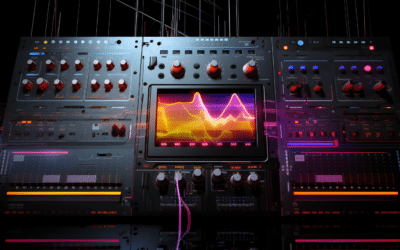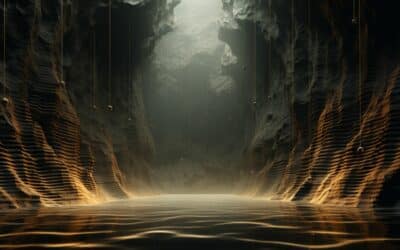Ever wondered why John Bonham’s drums sound so massive? Or what makes Whitney Houston’s vocals shimmer? Or why The XX sound so spacey? Reverb is a crucial contributor to what makes their recordings sound great. In this article, we’ll take you through a brief history of reverb, explain some reverb categories and settings, then run through some of our favorite reverb plugins.
What is a reverb plugin?
A reverb plugin is a device used in music production that simulates the effect of natural reverb. In other words, a reverb plugin artificially recreates the sound of a space.
But what is reverb? It’s the sonic reflection of sound waves off surfaces, giving the sound depth and ambience. By simulating spaces, like rooms or halls, reverb adds realism and helps immerse the listener. Besides delay, reverb is the most common effect used during mixing. It has plenty of other uses, so beginner producers should take time to learn its different properties.
Reverb plugins apply algorithms that simulate the reflections of spaces like rooms, halls, or chambers, OR mechanical devices such as metal plates or springs. Some algorithms go beyond recreating realistic reverb, instead simulating reflections in artificial “spaces” with non-linear responses.
Key Reverb Terminology and Settings
If you’re just starting out, you’ll want to know some common reverb terminology:
- Pre-delay: this refers to the time delay between the initial sound source and the onset of the reverberant tail. In general, this gives you control over the apparent size of the space the sound is in.
- Early reflections: This refers to the reflections in the reverb before the audio signal reaches its primary reverberant surface. A sound in the small room may audibly reflect off the floor, side walls, and any other surfaces in the room before reaching the opposite wall. In general, this means higher settings for early reflections makes the space seem smaller, and vice versa.
- Decay: Sometimes labeled “size,” this refers to the time in seconds it takes for the reverb to fade out. Decay contributes to the overall ambience of the reverberant sound and also allows you to control the apparent size of the space.
- Diffusion: Sometimes referred to as “density,” this affects the apparent loudness of the reverb reflection. Set low, the reverb tail will sound less audible and perhaps “thin.” High settings will create a denser reverb that may sound smoother in some mixes.
- Damping: Damping suppresses the high frequencies in the reverb. Low settings mean fewer high frequencies are absorbed for a brighter reverb sound. High settings limit the high frequencies in the reverb for a darker sound.
The Main Types of Reverb
If you’re a beginner, you’ll also want to get familiar with a few broad reverb categories.
First, there’s the natural acoustic reverb from physical spaces, like a hall, chamber, or stairwell (used in Led Zeppelin’s “When the Levee Breaks“). Getting the sound of a space means actually recording there. You can achieve this by finding a sweet spot in the room where the reverb sounds the best, then placing a separate mic there to record the ambience.
Next you have mechanical reverbs. Recording in physical spaces isn’t always practical, so early producers and engineers sought a more efficient way to achieve similar results. They found the solution by placing mechanical devices near sound sources.
Spring reverb was the first approach. As sound passes through metal springs, they create tiny echoes that mimic physical reverb. You’ll find the effect in vintage gear, like Fender guitar amplifiers from the 60s. Listen to surf rock classics like “Misirlou” to get a feel of its distinctive character.

Early audio engineers quickly found another approach by placing a metal plate near a sound source. Plate reverb‘s lush artificial reverberations offered a slightly warmer sound than spring reverb, soon becoming a favorite in recording studios.

Fast forward a few decades, and digital reverbs quickly became the production tool of choice. Algorithmic reverb is a subcategory of digital reverb that uses mathematical formulas to simulate natural spaces. These algorithms often take inspiration from real spaces but can also imagine artificial spaces that go beyond the real world’s possibilities. Convolution reverb is the other main digital reverb subcategory. Audio engineers record a sound in an actual space to capture how it reflects and diffuses the sound. This generates an impulse response that digital reverbs implement, recreating the effect of hearing a sound in that space.
The Top 5 Reverb Plugins
So now that you have your bearings on key reverb concepts, what should you buy? Read on for a deep dive into our favorite reverb plugins.
Valhalla DSP – ValhallaRoom

Released in 2011, ValhallaRoom is a no-frills affair with a simple interface to dial in powerful room reverb sounds. It gives users twelve algorithms spanning Large Room, Medium Room, and the massive Nostromo Room, making it a versatile, true stereo reverb.
Valhalla DSP designed the plugin from a psychoacoustic perspective, using spatial and phase cues for their algorithms. This creates more intricate responses than a simple room recreation.
You can also design chorus-esque effects by tweaking its depth and modulation settings. ‘Depth’ simulates making sound feel close or far away, similar to predelay. Its modulation setting makes the reflections shift and wobble slightly for a more dynamic sound. The Decay feature lets you dial up a maximum 100 seconds of reverb! While not practical for most use cases, this gives ambient producers a compelling option.
Unlike most reverb plugins, ValhallaRoom doesn’t offer a graphical display. This encourages you to listen to the subtleties of the reverb and train your ears to understand its interaction with other components of the mix.
Look no further than Valhalla Room if you’re after intricate room recreations, ease of use, and plenty of control over fine reverb details.
Valhalla Room Price: $50
Soundtoys – Little Plate

Soundtoys offers a suite of over a dozen plugins, most of which have become industry standards. As the name suggests, Little Plate is their digital recreation of plate reverb. Its simple design and intricate algorithms give users an authentic and versatile reverb effect. Don’t let the “little” in its name fool you though. It can give vocals, guitars, and keyboards the ambience needed to sound massive in your mix.
At its core, Little Plate offers an array of controls that allow precise shaping of the reverb’s character. Users can seamlessly transition from shorter, intimate spaces to grand, expansive environments by adjusting decay time, pre-delay, damping, and tone settings.
The plugin retains the essence of vintage hardware while incorporating modern enhancements, granting users the best of both worlds. It can infuse featured tracks like vocals and even entire mixes with the warmth and depth reminiscent of authentic physical plate reverb.
Recently, Soundtoys expanded the concept further with the release of SuperPlate, upping the ante with 5 different emulations of classic plate reverbs. The new Auto-Decay setting dynamically reduces the decay time after the audio crosses a threshold for a more musical approach to decay. They also refined the preamps to add more color and compression. They already had a head start with Little Plate, but the recent introduction of SuperPlate puts SoundToys firmly at the top the pack for plate reverb.
Soundtoys Price: $99
FabFilter – Pro-R

The Pro-R is FabFilter’s first (and only) reverb plugin. As discussed in our Best Delay Plugins feature, FabFilter’s sound quality sets it apart from other brands, and that extends to their Pro-R reverb plugin.
Fab Filter has always focused on novel approaches to user experience. With the Pro-R, rather than label things traditionally, they take a musical approach to feature names, with parameters like Brightness (EQ), Character (modulation), and Distance (pre-delay). In their words, getting good reverb sounds should not “require a degree in reverb science.”
Rather than imitating an analog unit, the Pro-R user interface provides a frequency spectrum analyzer with visualizations of EQ and decay curves. Both are accessible via the same window. At the time of its release, there was nothing quite like that. And despite this, it boasts near-zero latency, even in full-screen mode. Latency can ruin a plugin’s user experience but not in the case of Pro-R.
The Pro-R uses parametric EQ bands instead of a traditional EQ crossover system. This provides much more flexibility to shape the decay time characteristics. If you have a large decay setting on a guitar but find it too strong around the frequency of the guitar pick’s sound, you can tweak the decay time for that band alone. This highly surgical approach gives sound designer’s and engineers plenty of options at mixdown.
The Pro-R offers over 150 excellent and wide-ranging presets. A true reverb workhorse, it provides unmatched musical control over your mix.
Pro-R Price: $169
Strymon – BigSky

The BigSky is the only reverb plugin on our list that emulates a hardware unit, Strymon’s BigSky Reverb Pedal, an effects unit extremely popular with guitarists.
Like the BigSkypedal, the BigSky plugin conjures instantly recognizable ethereal reverberations. It can take you from subtle ambiances to vast, immersive soundscapes. Released in November 2022, it quickly established itself amongst the producer community.
Bigsky covers vast, immersive, nearly infinite decays to responsive plates perfectly tuned to organically accentuate vocal performances. It includes a switch to toggle between Infinite and Freeze. Infinite allows your reverbs to sustain indefinitely, with each new note you play adding to the reverb signal – perfect for pads, guitar ambiance, or building soundscapes. Alternatively, Freeze also gives you infinite sustain but allows you to play new unprocessed notes on top of the sustained signal without adding to the reverb.
It has 12 reverb algorithms, including Swell, Bloom, Cloud, and Shimmer. Each algorithm also has unique settings with separate tone controls.
Despite the heavy feature set, it has no hidden submenus. The user interface changes, updating its controls based on the selected algorithm for added ease of use.
While not as surgical as the Pro-R, BigSky is a great option for blanketing specific instrument tracks with rich, unique reverb tones. Its unique sound quality builds on years of hardware manufacturing by Strymon.
BigSky Price $199
Baby Audio – Crystalline

Baby Audio is the youngest effects developer on this list. Their reverb plugin Crystalline made waves by taking a modern approach to reverb. Rather than trying to sound like a real spaces, Crystalline embraces artificial reverb by simulating spaces that aren’t possible in the real world. It achieves this by matching advanced computing with modern algorithms, giving you an experimental yet clean sound.
The user interface gives you four broad menu sections: Reflections, Depth, Shape (tone), and Clean Up (damping). Each has three controls for further shaping.
Users can match the attack and decay to the beat, making your reverb flow rhythmically with your music. The Ducker setting interacts with these rhythmic features to keep the reverb from competing with other sounds in your mix. This helps steer clear of reverb’s tendency to create muddy mixes, especially on drums or vocal tracks.
Crystalline’s Freeze setting enables endless reverb echoes. If you’re a preset surfer, you can use the Dry/Wet and Wet Lock options to lock your Freeze settings while you try out different presets. This is great for when you have the right balance but want to experiment with different reverbs.
Unlike most reverb effects, Crystalline separates the reverb size and length settings. This means you can get any size and length combination you desire, from short tails to massive spaces. The Sparkle parameter emphasizes your high frequencies, great for snares, vocals, or atmospheres. The reverse reverb settings is there to help transition between sections, like building anticipation for a chorus.
What we like about Crystalline is that it forces you to think differently. Don’t get hung up on the science of reverb. Instead, tweak, experiment, and put the music first.
Price: $99
Final Thoughts
Reverb can take a lot of work to get right in the mix. The differences between a good mix and a great one are often how reverb is applied. It can be used subtly or as a noticeable effect – such as the gated reverb on the drums and vocals ‘In The Air Tonight’ by Phil Collins.
It’s such a common effect that learning it will elevate your mixes. And then you’ll start hearing it on other records too. This list provides an idea of the best in class reverb plugins to help you pick what’s right for you.
Good luck in the ether!




